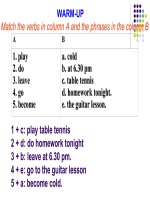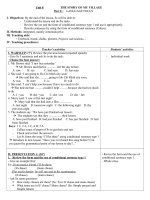UNIT 8. LANGUAGE
Bạn đang xem bản rút gọn của tài liệu. Xem và tải ngay bản đầy đủ của tài liệu tại đây (1 MB, 24 trang )
<span class='text_page_counter'>(1)</span><div class='page_container' data-page=1>
<b>UNIT 8</b>
</div>
<span class='text_page_counter'>(2)</span><div class='page_container' data-page=2></div>
<span class='text_page_counter'>(3)</span><div class='page_container' data-page=3>
<b>A</b>
<b>Smartphon</b>
<b>e</b>
</div>
<span class='text_page_counter'>(4)</span><div class='page_container' data-page=4>
<b>B</b>
<b>laptop</b>
</div>
<span class='text_page_counter'>(5)</span><div class='page_container' data-page=5>
<b>C</b>
<b>tablet</b>
</div>
<span class='text_page_counter'>(6)</span><div class='page_container' data-page=6>
Match each of the phrases on the left with its
explanation on the right.
1. take notes of
something
2. touch screen
3. take advantage
of something
4. look something
up
5. access
something
a. reach and use something
b. make use of something
to the fullest extent
c. search for and find
something in a dictionary or
a reference book.
d. sreen which allows giving
instructions by touching
</div>
<span class='text_page_counter'>(7)</span><div class='page_container' data-page=7>
Read the conversation in Getting Started again.
Match pictures A-C with their uses as learning tools
1-6 mentioned below.
1. access the Internet, download
programmes and information
2. take notes with a digital pen on a
touch screen.
3. take photos or record students’
work
4. do assignments and projects, and
study English.
5. store information, take notes, write
essays and do calculations
6. look up information
<b>A</b>
<b>B</b>
<b>C</b>
<b> A, B, C</b>
<b> A, C</b>
<b> A, B, C</b>
<b> B</b>
<b> B</b>
</div>
<span class='text_page_counter'>(8)</span><div class='page_container' data-page=8>
Pronunciation
1. Listen and repeat.
1. concentrate similar contribute digital
2. introduce excellent recognize
Vietnamese
</div>
<span class='text_page_counter'>(9)</span><div class='page_container' data-page=9>
2. Listen again and put a mark (‘)
before the stressed syllable.
1. concentrate similar contribute digital
2. introduce excellent recognize
Vietnamese
3. understand personal interest symbolic
<i>Note: </i>
</div>
<span class='text_page_counter'>(10)</span><div class='page_container' data-page=10>
<b>GRAMMAR</b>
</div>
<span class='text_page_counter'>(11)</span><div class='page_container' data-page=11>
1.They are the modern devices that
have changed the way we learn.
2.My laptop, which is a present from
my parents, is very useful.
3.A tablet is also perfect for people
whose work is to draw and write.
4.That man who came to fix the
internet access for me was skillful.
</div>
<span class='text_page_counter'>(12)</span><div class='page_container' data-page=12>
<b>Relative </b>
<b>Pronouns</b>
<b>who(m)</b>
<b>whose</b>
</div>
<span class='text_page_counter'>(13)</span><div class='page_container' data-page=13>
Grammar
<i>A relative clause is used </i>
<i>to modify </i>
<i>the noun </i>
<i>or</i>
<i>pronoun</i>
<i>that stands </i>
<i>right before it </i>
<i>.</i>
- My tablet, which is two years old,
still works quite well.
-
Sometimes we omit the
<i>wh-pronoun</i>
</div>
<span class='text_page_counter'>(14)</span><div class='page_container' data-page=14>
Laptop common noun
whose cover is decorated with funny animals
<b>defining relative clause</b>
The laptop whose cover is decorated
with funny animals belongs to my aunt.
</div>
<span class='text_page_counter'>(15)</span><div class='page_container' data-page=15>
Long , who is only two and a half,
likes to play games on a tablet.
Long <sub>proper noun</sub>
who is only two and a half
non-defining relative clause
</div>
<span class='text_page_counter'>(16)</span><div class='page_container' data-page=16>
1. I talked to a man whose smartphone was
stolen.
</div>
<span class='text_page_counter'>(17)</span><div class='page_container' data-page=17>
1. Relative clauses are divided into two types:
• <sub>Defining relative clauses (MĐQH xác định): </sub><i><sub>→Xác </sub></i>
<i>định danh từ đứng trước là ai, đối tượng/ vật nào</i>
• <sub>Non-defining relative clauses (MĐQH khơng xác </sub>
định <i>→ bổ sung thêm thông tin cho danh từ đứng </i>
<i>trước, tách với danh từ bằng dấu phẩy.</i>
Examples:
- I often use the desktop which my parents bought
me five years ago.
- This is my tablet, which uses the latest digital
technology.
<b>Defining: which desktop</b> ?
<b>Non-defining</b>
</div>
<span class='text_page_counter'>(18)</span><div class='page_container' data-page=18>
2. Non-defining relative clauses are used when
the preceding nouns may include:
• <b><sub>Demonstrative: This, that, these, those</sub></b>
• <b><sub>Possessive: my, his, her, their…</sub></b>
• <b><sub>Proper noun: John, Hoa, Obama…</sub></b>
</div>
<span class='text_page_counter'>(19)</span><div class='page_container' data-page=19>
<b>Watch out! (Page 28)</b>
- <sub>A defining relative clause gives detailed </sub>
and necessary information without which
the sentence is incomplete. It is <b>not</b>
placed between, or after comma(s).
Examples:
- <sub>The man </sub><sub>who came to visit us </sub><sub>is a </sub>
computer engineer.
- <sub>An e-book is an electronic book </sub><sub>which </sub>
</div>
<span class='text_page_counter'>(20)</span><div class='page_container' data-page=20>
<b>Watch out! (Page 28)</b>
A non-defining relative clause give extra
information without which the sentence
is still complete. It is placed between , or
after comma(s).
Example:
That man, who came to visit us, is a computer
engineer.
This is my brother, who is a computer engineer.
<b>Non-defining relative clauses cannot use </b>
</div>
<span class='text_page_counter'>(21)</span><div class='page_container' data-page=21>
1. I talked to a man
2. We often visit our
grandfather in Vinh,
3. Thank you very
much for the book
4. The man turned
out to be her son,
5. He admires people
6. Have you heard of
John Atanasoff,
a. that you sent me.
b. whose invention
changed the world?
c. who are wealthy and
successful.
d. which is a city in
central Viet Nam
e. whose smartphone
was stolen.
f. who had gone
missing during the war.
<b>A</b>
<b>B</b>
</div>
<span class='text_page_counter'>(22)</span><div class='page_container' data-page=22>
<b>Revision </b>
<i>Relative pronouns after nouns that are:</i>
1...N (person) + ________ + V
2....N (person) + ________ + S- V
3... N (thing) + ________ + V/ S- V
4. ... N (person/thing) + __________ + V/ S-V
(không dùng sau dấu phẩy/ non-defining)
5...N1 + _____________ + N2 ...
(N2 thuộc sở hữu N1)
<b>WHO</b>
<b>WHOM</b>
<b>WHICH</b>
<b>THAT</b>
</div>
<span class='text_page_counter'>(23)</span><div class='page_container' data-page=23>
1. Personal electronic devices ________ distract students
from their class work are banned in most schools.
2. The laptop ________ cover is decorated with funny animals
belongs to my aunt.
3. My tablet, ________ is two years old, still works quite well.
4. Students ________ have smart phones can use them to
look up words in an electronic devices.
5. Some scientists think that children ______ parents allow
them to use electronic devices early will have more
advantages in the future.
6. Long , ____ is only two and a half, likes to play games on a
tablet.
Using who , which, that or whose to complete
each of the sentences.
</div>
<span class='text_page_counter'>(24)</span><div class='page_container' data-page=24>
<b>Homework</b>
-
<b><sub>Reviewing grammar point</sub></b>
-
<b><sub>Doing exercise in workbook</sub></b>
</div>
<!--links-->









